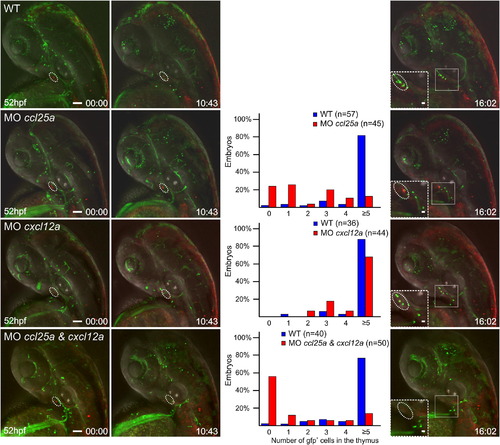Fig. 6
|
Chemokines Regulate Thymus Homing Double-transgenic fish (ikaros:eGFP [green fluorescence]; foxn1:mCherry [red fluorescence]) were injected with gene-specific antisense morpholinos singly or in combination. The type of gene-specific morphant is indicated at the top of panels in the first column. The cxcl12b morphant exhibits a prethymic defect. See also Figures S4–S6. Shown are still photographs from movies taken at several different time points, beginning at 52 hpf (00 hr:00 min; first column). The panels of the latest time point (fourth column) contain insets depicting enlargements of the thymic (white dotted line) and parathymic regions. At 63 hpf, the numbers of cells present in the thymic rudiments (marked with circles) was determined and are presented in the third column. The presence of e5 cells per rudiment was considered to be indicative of normal colonization; hence, for statistical purposes, the fraction of embryos with 0–4 intrathymic cells was compared to those containing e5 cells: ccl25a morphant, p < 1.274 × 1012; cxcl12a morphant, p < 0.033; ccl25a and cxcl12a double-morphant, p < 8.32 × 1010; Fisher′s exact probability test. The numbers of embryos analyzed for each group are indicated. Scale bars represent 50 μm for overviews, 10 μm for high-power views (insets). The numbers of embryos that were subjected to the analyses are shown in each panel. See also Movie S7. Thymus Homing Process in a Double-Transgenic Wild-Type Embryo and Movie S8. Thymus Homing Process in a Double-Transgenic Embryo Injected with Morpholinos Targeting ccl25a and cxcl12a. |
| Genes: | |
|---|---|
| Fish: | |
| Knockdown Reagents: | |
| Anatomical Terms: | |
| Stage: | Long-pec |
| Fish: | |
|---|---|
| Knockdown Reagents: | |
| Observed In: | |
| Stage: | Long-pec |
Reprinted from Immunity, 36(2), Hess, I., and Boehm, T., Intravital Imaging of Thymopoiesis Reveals Dynamic Lympho-Epithelial Interactions, 298-309, Copyright (2012) with permission from Elsevier. Full text @ Immunity

